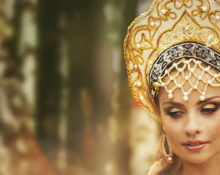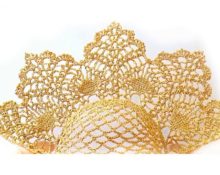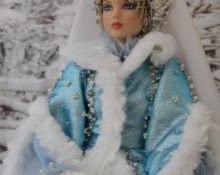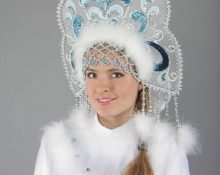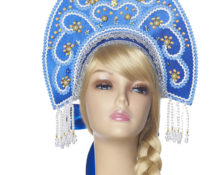Kokoshnik is an element of the Russian national costume, a mysterious and intricate headdress that adorns all women who have ever worn it, which has no analogues in the world in terms of complexity and beauty. So what is it and what does it look like?
What kind of headdress is this?
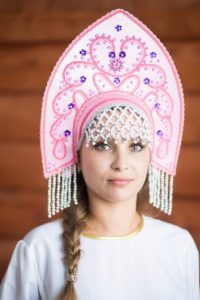 Kokoshnik is a tall, embroidered, elegant design of a woman’s headdress that hides her hair. The name contains the Old Russian word “rooster”. Probably, our ancestors associated its geometry with the cock’s comb. It is symbolic that its main distinguishing feature is the presence of an original element - a ridge, around which the entire composition is built.
Kokoshnik is a tall, embroidered, elegant design of a woman’s headdress that hides her hair. The name contains the Old Russian word “rooster”. Probably, our ancestors associated its geometry with the cock’s comb. It is symbolic that its main distinguishing feature is the presence of an original element - a ridge, around which the entire composition is built.
The kokoshnik was a lightweight structure in the form of a fan or fan; a hairline or cap was sewn onto it, intricately decorated. The tight coverage of the head ensured a secure fit and concealment of braided or styled hair.
In each region, the kokoshnik had its own shape.Some provinces were famous for their one-horned kokoshniks, others wore two-horned ones. Villages located at a short distance from each other could wear caps or crescents.
Important! A lot could be determined by the headdress in Rus'. The kokoshnik served as an indicator of the status of its owner, her social status, age and place of origin.
Historical reference
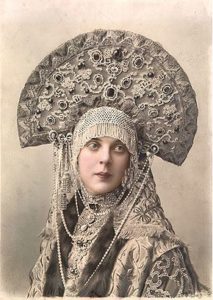 The appearance of such an intricate headdress in women's attire has not been clarified for certain. Historians admit that such a complex design was created as a borrowing from the Byzantine matrons, who decorated themselves with tiaras attached to their hair with ribbons. One way or another, the kokoshnik has been known in Rus' for more than 10 centuries, which is supported by numerous evidence found in excavations of ancient burial mounds.
The appearance of such an intricate headdress in women's attire has not been clarified for certain. Historians admit that such a complex design was created as a borrowing from the Byzantine matrons, who decorated themselves with tiaras attached to their hair with ribbons. One way or another, the kokoshnik has been known in Rus' for more than 10 centuries, which is supported by numerous evidence found in excavations of ancient burial mounds.
Peter 1 banned the wearing of Russian dresses for the nobility, but the peasantry maintained centuries-old traditions and continued to wear sundresses and kokoshniks. Their rehabilitation took place under Catherine the Great, who introduced much of Russian life into fashion, including hats. The Patriotic War of 1812 cemented the fashion, so much so that in addition to kokoshniks with veils, noble women began to wear dresses that resembled Russian high-cut sundresses in the Empire style.
Visitors to art galleries, for example, the Russian Museum in St. Petersburg, can see firsthand the popularity of Russian costume among the Russian aristocracy. Almost all female portraits of the 18th-19th centuries show beauties in elegant secular dresses with a kokoshnik and a veil on their heads.
Women from the royal families also dressed according to the fashion of those years. Their headdresses were decorated not only with pearls, but also with jewelry of significant size, and the veil was made of the finest, ethereal fabrics and often went down to the floor.
The ladies of the court wore open Western outfits and a Russian kokoshnik, which was preserved by socialites until the revolutionary events of the early 20th century.
Russian emigrants who opened fashion houses in Paris at the beginning of the last century began to introduce Slavic traditions into the life of Europeans. For example, at this time, through their efforts, a wedding crown, created according to Russian motives in the shape of a crescent-shaped kokoshnik, became popular.
Many brides got married in tiaras, which were essentially Russian headdresses. And Hollywood actresses in the 20-30s of the last century loved to appear in society in richly decorated kokoshniks. And even Queen Mary of England, who is Elizabeth’s Second grandmother, walked to the crown with a tiara (crescent) on her head.
About the kokoshnik in detail
In different provinces of Russia, kokoshniks of different shapes, designs, details, and decorations were worn. This was usually associated with regional customs of laying out hair, which was collected in braids or a plait. They were twisted around the head, laid out above the forehead, divided in two and hidden in the temple area, and masked at the back of the head.
Types of kokoshniks
The use of different hats, united by common characteristics, is explained by the residence of women in different territories. Depending on this, they can be divided into the following groups:
 horned (one-horned or two-horned) kokoshnik;
horned (one-horned or two-horned) kokoshnik;- saddle-shaped - which is a special headdress, where the front element is raised above the back with a high rounded top, like a saddle.It was always accompanied by a forehead in the form of an embroidered ribbon or a narrow strip of fabric with an embroidered ornament;
- the round shape of a flat-bottomed hat is always very richly decorated; this variety could not be found without embroidery with gold or silver threads, beads, mother-of-pearl or pearls. A scarf folded at an angle was thrown over the top, the edges of which were fixed under the chin;
- kokoshniks, which have a flat oval top, protrusions near the forehead and blades in the ear area - these headdresses were crowned with a white scarf on which ornaments were embroidered in gold.
One-horned kokoshniks were divided into three types:
- like an isosceles triangle;
- like a cone with an elongated front part;
- like a tall hat with a flat-rounded top.
What were they made of?
The basis for them was birch bark; later they were made from thick cardboard. They were lined with rich fabrics, using velvet, brocade, and calico. Thin, light materials served as a cover for the hair. Jewelry could not be imagined without embroidery, braid, beads, pearls, beads; models for rich wives and maidens included precious stones.
Details and their meaning
The kokoshnik was supplemented and decorated with different types of blades, edges, back plates and other details, which could differ significantly from each other in different regions:
 Obnizi (below) hid the forehead up to the brow ridges or just below them in the form of a mesh of pearls or beads.
Obnizi (below) hid the forehead up to the brow ridges or just below them in the form of a mesh of pearls or beads.- The back of the head hid the hair laid at the back of the head. They sewed it on canvas, but with velvet stitching, and secured it with ribbons at the back.
- The side of the kokoshnik was often decorated with ryasny - long threads of pearls or beads.
- The blades covered the styled hair in the ear area.
What does embroidery mean?
Unusual patterns with alternating elements were placed on the most prominent parts of the kokoshnik.The embodiment of symbols and rituals in ancient folk ornaments is reflected in the embroidery on the comb and headband of the headdress.
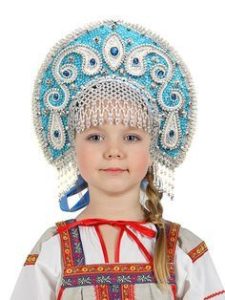 The sun, as a symbol of the source of life in ancient beliefs, had the greatest power that purified and protected man. This symbol is used to decorate the vast majority of embroideries found on the clothes and household items of Russians. Human traits were betrayed to the earth. She seemed to the Russians to be a woman who raised her hands high with birds.
The sun, as a symbol of the source of life in ancient beliefs, had the greatest power that purified and protected man. This symbol is used to decorate the vast majority of embroideries found on the clothes and household items of Russians. Human traits were betrayed to the earth. She seemed to the Russians to be a woman who raised her hands high with birds.
Another popular symbol present on embroidery was a bird. Russian people have always believed that a bird can bring him only one good thing.. The horse acted as a symbol of the guardian of the hearth and was perceived as the most powerful domestic animal. A tree, the tree of life, is the most ancient symbol that embodies the concepts of our ancestors about the structure of the world (the Universe). Their naive ideas about the paradise gardens in the sky and the growth of a miracle tree there that bears magical fruits are reflected in the embroidery patterns of kokoshniks.
Additions to the kokoshnik
Its top was often covered with ubrus or veil (haze, veil). The scarf was worn folded into a triangle. The method of joining the ends of the scarf is pinning in the neck area. A beautiful thin veil-veil was also worn pinned in front or allowed to fall freely and cover the shoulders, back, and chest.
Important! Ubrus is a scarf made of silk or wool, with dense embroidered patterns in gold and silver. A veil is a head cape made of thin, light fabrics, embroidered at the edges or decorated at the bottom with narrow strips of lace or braids.
Mysticism and rituals associated with it
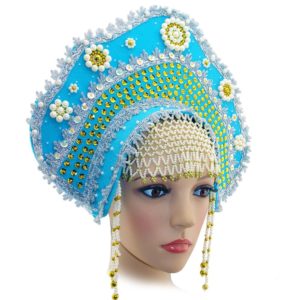 In the minds of the Russians, women's hair had to be covered with a headdress. It was believed that if uncovered, they would bring misfortune not only to their owner, but to the family and the entire clan.. A lot of things were attributed to non-compliance with traditions: illness and loss of livestock, crop failure, all sorts of misfortunes with loved ones.
In the minds of the Russians, women's hair had to be covered with a headdress. It was believed that if uncovered, they would bring misfortune not only to their owner, but to the family and the entire clan.. A lot of things were attributed to non-compliance with traditions: illness and loss of livestock, crop failure, all sorts of misfortunes with loved ones.
The first thing to do was to tear off the warrior's hair from a wife who cheated on her husband so that the hair would be visible to everyone. Thus sin was exposed to general condemnation. Harlots and mermaids walked with their hair down. This is where the words “promiscuity” and “foolishness” come from.
The girls put on a kokoshnik, leaving their hair on the top and braid open. Thick and long, it was considered a symbol of girlish beauty and served to attract the attention of potential suitors. A married woman had the right to wear a kokoshnik only with a covering layer, under which the hair was completely hidden.
After the wedding, when the girl’s status changed, a ceremony was held at which the woman said goodbye to her maiden beauty. To the accompaniment of sad songs, the bride's braid was unraveled and made into two. The mother-in-law put a kokoshnik with a thin veil on her daughter-in-law; sometimes the muslin was replaced with a scarf, tying it like a woman, from below the chin.
This headdress was festive and was not worn in everyday life. Warriors were in use, which were replaced by low crowns. The bride had to get married wearing a pearl kokoshnik. Its cheap options covered the family with shame. If parents were unable to buy an expensive headdress due to poverty, they would borrow it from neighboring families.
They wore it on holidays until the birth of the first child, then the kokoshnik was returned to the owners. In the largest and most progressive regions, the mandatory wearing of a kokoshnik after a wedding was determined by a three-day period.. They kept their own pearl jewelry very carefully and passed it on to the eldest daughter-in-law, and in the absence of one, to the eldest daughter as a significant part of the dowry.
What place does the kokoshnik occupy in modern fashion?
This headdress, as part of the traditional Russian costume, has always been present on stage. Artists of singing and dancing groups performing folk songs and dances in their repertoire demonstrate at concerts kokoshniks of incredible beauty, made in folk and modern techniques:
 As part of a carnival outfit or a Snow Maiden costume, the original headdress has been popular for decades.
As part of a carnival outfit or a Snow Maiden costume, the original headdress has been popular for decades.- Queen Amidala from Star Wars appears in the second episode wearing a gold traveling costume with a headdress based on the Russian kokoshnik.
- The French fashion house of Karl Lagerfeld, to present the new 2008-2009 collection Paris-Moscou, used the kokoshnik as a starting point to create fantasy examples of headdresses for models on the catwalk.
- The football championship that took place in Russia made it a trend that women, men and children tried on. Although fans from the very first game appeared in the stands wearing Russian headdresses, the rise was determined by the famous “trinity in kokoshniks” at the match between the Russian and Spanish national teams. Sales of the national headdress have soared, fueled by the demand of foreign fans for Russian souvenirs. So the kokoshnik became the emblem of the 2018 World Cup.


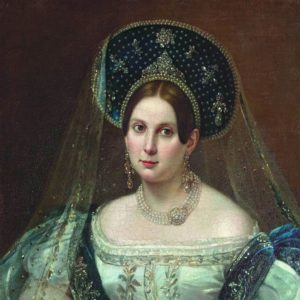 horned (one-horned or two-horned) kokoshnik;
horned (one-horned or two-horned) kokoshnik;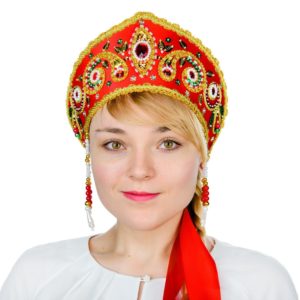 Obnizi (below) hid the forehead up to the brow ridges or just below them in the form of a mesh of pearls or beads.
Obnizi (below) hid the forehead up to the brow ridges or just below them in the form of a mesh of pearls or beads.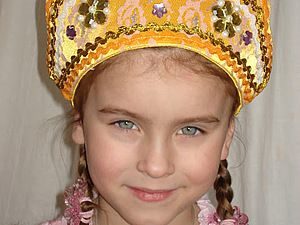 As part of a carnival outfit or a Snow Maiden costume, the original headdress has been popular for decades.
As part of a carnival outfit or a Snow Maiden costume, the original headdress has been popular for decades. 0
0